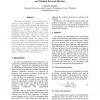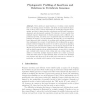735 search results - page 3 / 147 » A Mechanization of Phylogenetic Trees |
SODA
2010
ACM
14 years 8 months ago
2010
ACM
BIOINFORMATICS
2010
13 years 11 months ago
2010
Phylogenetic trees are widely used to display estimates of how groups of species evolved. Each phylogenetic tree can be seen as a collection of clusters, subgroups of the species ...
CSB
2005
IEEE
14 years 4 months ago
2005
IEEE
Traditional phylogenetic tree reconstruction is based on point mutations of a single gene. This approach is hardly suitable for genomes whose genes are almost identical and hardly...
ALMOB
2007
13 years 11 months ago
2007
Background: Neighbor-Net is a novel method for phylogenetic analysis that is currently being widely used in areas such as virology, bacteriology, and plant evolution. Given an inp...
RECOMB
2006
Springer
14 years 11 months ago
2006
Springer
Micro-indels are small insertion or deletion events (indels) that occur during genome evolution. The study of micro-indels is important, both in order to better understand the unde...


